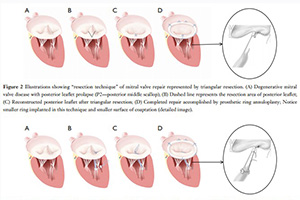Chordae replacement versus leaflet resection in minimally invasive mitral valve repair
Abstract
For many years, the quadrangular resection technique first proposed by Carpentier has become the gold standard for repair of posterior leaflet prolapse of the mitral valve (MV). Although this “resection” technique and its modifications are safe and very effective, they do not respect the anatomy of the MV and the physiological role of the posterior leaflet. Therefore some new techniques, aiming to preserve MV leaflets to a different extent, have been proposed. With the use of expanded polytetrafluoroethylene (ePTFE), neochordae leaflet preserving techniques for posterior MV prolapse treatment have emerged. The aim of these techniques is to support the free edge of the prolapsing segments and thereby restore the physiologic function of the MV. A simplified modification of this technique using premeasured ePTFE loops (“loop technique”) was successfully introduced to ease the implantation of neochordae, especially in the setting of minimally invasive MV surgery.
While “resection” techniques are associated with excellent long-term results, there is evolving evidence in favor of “non-resection” techniques supporting the concept of a “respect rather than resect” approach.
Cover






